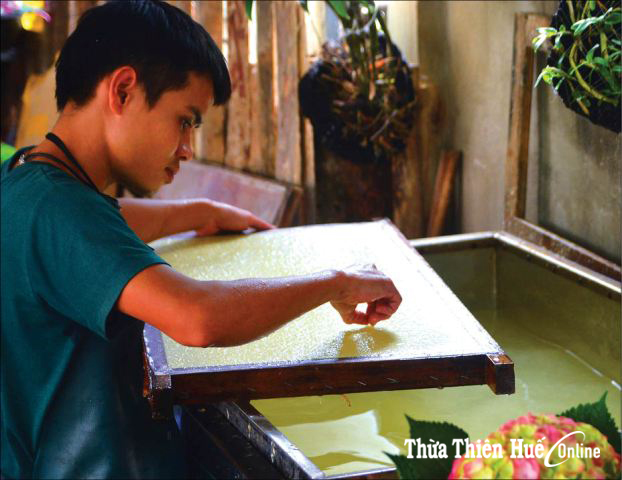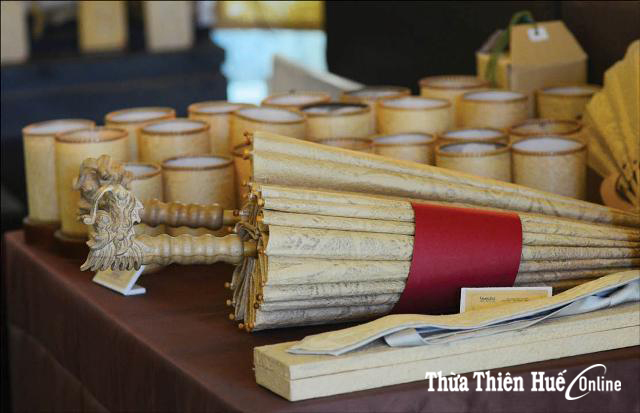
Couching paper. Photo: Trucchi art
Vietnamese paper art
From the notion that paper does not necessarily have to stop at the "function" as a canvas, painter Phan Hai Bang - lecturer of the University of Arts - Hue University, the founder of Vietnam Trucchi Art Project, took the story of paper crafting beyond that of a material that supports normal creativity, into an independent, self-contained work of art.
After the research and creation, Phan Hai Bang and his collaborators have created a new type of art – paper art, adding art-paper as a new concept alongside the concept of dó paper, an achievement of the Vietnamese tradition which has been affirmed. One of the technical foundations of Trucchi art is trucchigraphy - a unique combination of paper making, water-pressure technique and the principle of printmaking.
The term trucchi was coined by the writer, researcher and translator Buu Y in 2012, with the notion of the image of bamboo to promote the spirit and symbol of Vietnamese culture. Trucchi is meant to be a type of paper art of the Vietnamese, created by the Vietnamese, not just to name a material. The Japanese has washi, the Korean has hanji, the Chinese has xuyenchi and Vietnam now has trucchi. Hue is the birthplace of trucchi art.
Painter Phan Hai Bang shared: With the spirit of "Continual transformation of tradition", from the beginning, we exploited and applied the traditional craft in a flexible and adaptable manner with different processes, techniques and methods to create art. Locally available materials such as straw, bamboo, sugarcane, banana trees, paper mulberry, duckweed, leaf, grass, etc. were studied and tested. Each type of material needed a different treatment process and gave different pleasures in visual expression and visualization. This opened up many different approaches and exploitations later in the creation.

Trucchi product. Photo: Võ Nhân
Spreading into life
If traditional artworks (wall hangings) are almost exclusively felt at the surface effect under the direct sunlight, trucchi work can be felt at the surface effect and the light-shining effect of reverse light. Trucchi can be reciprocated and is suitable for different lighting and space conditions so it is possible to naturally participate in the play of contemporary art when it is possible to express all the themes, ideas, and visual effects that the artist desires, from traditional wall paintings to installation projects, media, contemporary art...
In addition to the individual works, trucchi art is mainly long-term projects, including a system of large and unique works. The exhibition "Trucchi – Listen to the River" (version 2017) recently held at Da Nang Museum of Fine Arts is rated by the art world as beautiful visually, strange in terms of material and process, with a sophisticated system of works, including the 150m long trucchi "river". The development of trucchi from birth to now is gradually being perfected, not only in size but also in the mode of expression and graphic techniques.
Many painters have found in Trucchi a new and unique way of expressing their artistic achievements in domestic and international art. Many works, art projects, university graduation projects on trucchi show the educational, aesthetic and social effects as the development criteria of Vietnamese trucchi art. Having won a number of prizes at national art exhibitions with trucchi art, female artist Ngo Dinh Bao Vi expressed, “I came to trucchi just because I found something in common with my journey. Trucchi art is just a new, vast land for creativity. Its use stretches and there are no signs of difficulty for any idea or concept. Expressions can be created with trucchigraphy.”
Bao Vi is also the developer of trucchi in the direction of applied art, parallel to the art of shaping. She is responsible for designing applications in trucchi product design, souvenir, interior design, fashion accessories, jewelry, etc. Trucchi artworks, such as hats, umbrellas, fans, purses, ties, lanterns, come into social life as an accepted value. In addition to the independent design, trucchi combined with the traditional villages in Hue, such as Sinh village paintings, Thanh Tien paper flowers, hats, kites, fans, umbrellas ... to create special products. For example, the Bat am lamp is a combination of trucchi with the Sinh village paintings, Bao La bamboo, embroidery and bronze casting. Thus, the works, the trucchi products gradually come into life naturally.
Bao Vi excitedly shared: "In addition to the traditional trend of shaping, we are working hard to create a contemporary trucchi application. With the seemingly infinite ability in trucchi, we wish that the Vietnamese spirit would exist everywhere through the form of trucchi art ... ".
Trucchi has also become a special souvenir product that many units and agencies order. In particular, a trucchi painting of the South Gate was presented to the Japanese Emperor when visiting Hue in March 2017. Artist Phan Hai Bang shared: "Japan prides itself on highly sophisticated paper craft, but it's hardly built to be a self-made paper art. We have done just that and we have the right to be proud." In the experience space at number 5 Thach Han, Hue, trucchi attracts a considerable number of visitors, especially international visitors to visit, experiencing not only trucchi but also a culture of Hue with all five senses. In that way, trucchi is known by many, spreading and becoming a new value of Hue besides Thanh Tien paper flowers, Sinh village paintings... as desired by painter Phan Hai Bang when starting to create trucchi.
Story: TRANG HIỀN